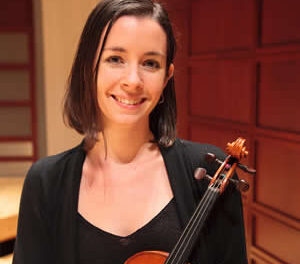The lights dimmed in the grand Meymandi Concert Hall at 7:30 p.m. on Sunday, December 23, as the North Carolina Symphony played the starting notes of the well loved “Christmas Canon” (arr. Lon Beery). The atmosphere wasn’t dark for long, however. As the orchestra continued to play, girls in bright red dresses and boys wearing red bowties lined the two main aisles of the hall, each child holding a battery-operated candle. The long rows of candles flickered beautifully in the dim lighting as the children made their way with grace towards the stage and up onto the risers behind the orchestra, all the while singing in their angelic voices about Christmas joy. It was a magical scene, the kind that puts an audience in a trance and captures its attention. This was a wonderful way to open the North Carolina Symphony’s A Candlelight Christmas.
For this concert program (which, according to the NCS’s website, was brought back by popular demand), a children’s choir was formed from students at Heritage Elementary School and Heritage Middle School. Jeremy Tucker, artistic director of The Raleigh Boychoir, was charged with training and directing this temporary choir, along with the music teachers at those two schools. The ensemble was named the North Carolina Children’s Chorus and consisted of around fifty singers. As depicted in the above description, the opening number was absolutely stunning. The choir’s intonation was spot on and their articulation so impressive that every word could be understood.
In addition to “Christmas Canon,” the North Carolina Children’s Chorus joined the NC Symphony for four other pieces. The second number on the program was David Willcocks‘ arrangement of “Ding Dong Merrily on High.” This began with a fast and intricate flute solo, perfectly played, after which the choir erupted into song. The children sang confidently and the joy that was on their faces could be heard in their voices. Another shining moment in the program for the chorus was their touching performance of “Somewhere in My Memory” by John Williams, from Home Alone, conducted by Tucker (who also led the elaborate processional); this was a favorite for many. Nostalgia floated out across the audience as the full but tender sound of fifty children singing about Christmas joys and memories filled Meymandi Hall.
In addition to well known holiday songs, this creatively-designed concert program also featured repertoire from some of the great classical composers including Richard Strauss, Samuel Barber, Nikolai Rimsky-Korsakov, and Vaughan Williams. A performance of Barber’s “Die Natali,” from the Choral Preludes for Christmas, Op. 37, was especially remarkable. Barber created this piece by combining a variety of sacred Christmas songs and putting his own twist on them. “Die Natali” is certainly not your standard Christmas medley; the Christmas songs within the piece are recognizable but only barely so, with extremely complex harmonization, new rhythms, and creative transitions. With all its different parts and changing melodies, the piece was a puzzle that the North Carolina Symphony fit together excellently; not a bumpy transition or fumbled rhythm was to be found in the performance. It is a fairly lengthy piece with every instrument section given an opportunity to take prominence. Bravo to the brasses for opening the piece with the warmest and most gentle blend of sounds possible and to all the various instruments with solo moments. It was a truly outstanding performance of a remarkable composition.
Following that and the John Williams, the NCS performed Rimsky-Korsakov’s Polonaise, from Christmas Eve, and Vaughan Williams’ “Fantasia on Greensleeves.” Strategically placed beside each other on the program, the contrast in these two pieces kept the audience engaged and showcased the ability of the orchestra to play vastly different styles accurately. The musicians perfectly captured both the bold, punchy sound of the Rimsky-Korsakov and the rich, warm tone of “Greensleeves.”
As per tradition, this program also featured one of the orchestra’s members as a soloist. Peng Li, assistant principal cello, was heard in this concert, and the chosen piece was Pyotr Ilyich Tchaikovsky‘s Andante Cantabile, from String Quartet No. 1, Op. 11. Beloved from its premiere, the piece was later arranged by Tchaikovsky for solo cello and string orchestra. It is beautiful, with a melody line capable of stirring hearts and drawing up tears, and Li played it rightly so. His crystal clear tone and fast vibrato produced the tenderest of sounds. Much of the piece was written in a frighteningly high register, but no quality of sound was lost when Li shifted to those positions. He played the solo piece as if it were as easy as breathing, and the orchestra breathed easily with him. Li’s solo was beautiful in every way and, judging from the lengthy applause that followed, the audience was moved by the performance.
The concert ended with two Christmas carols, “Hark! The Herald Angels Sing” (arr. David Willcocks) and “Silent Night” (arr. David Harris). The audience turned on their candles and stood to join the children’s chorus in song. Meymandi was practically sold out, and it was quite the sight to see the massive audience united by the flickering of their candles and the singing of well loved carols.
Conductor Wesley Shulz said his hope for the concert was that it would be a reflective, contemplative, tender, and joyous experience for the audience. Although lengthy, this list of Shulz’s hopes for the concert was completed by the end of the hour-long performance. The admirable repertoire and expert musicians had the audience alternately smiling for one piece and then stirred. The concert gave people the opportunity to reminisce on old Christmas memories and make new ones in the process. The beautiful images and music from the concert will surely remain in the minds of the audience for a long time to come.












